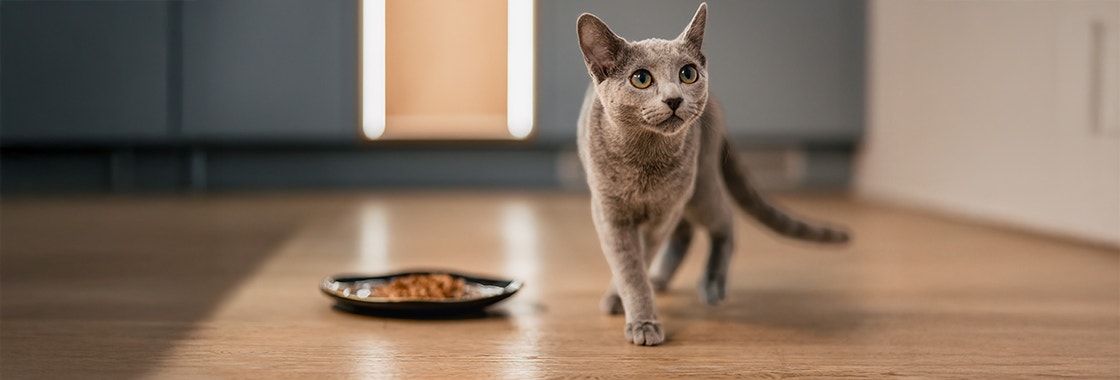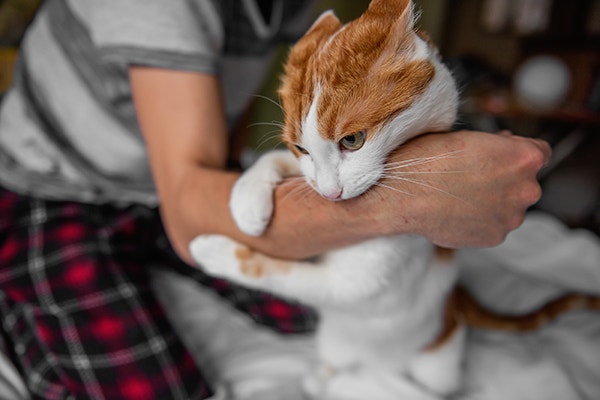Why your cat won’t eat wet food and what you can do about it


Share
Even the most enthusiastic eaters can suddenly turn up their noses at wet food. If your cat has always enjoyed mealtime, a refusal can be worrying. This is a common behaviour that can result from picky preferences, changes in the home environment, or underlying health issues.
Understanding why your cat is so picky about wet food can help you address the situation calmly and effectively. Some owners also wonder why their cat stops eating wet food but still eats dry food. In most cases, a combination of behavioural and health factors is at play, both of which can be managed with patience and attentive care.
By observing your cat closely and making minor adjustments to their feeding routine, you can often restore their appetite and help maintain a healthy diet. Remember, even gradual changes or minor improvements in environment and food presentation can make a big difference to a hesitant eater!
Why do cats refuse wet food?
Cats are naturally selective eaters, so it’s not unusual if your cat won’t eat wet food and is acting finicky. Sometimes, the reason is as simple as preference; some cats enjoy crunchy kibble more, while others may avoid wet food if the texture or smell isn’t appealing. Common aversions include certain textures, such as pâté, chunks, or gravy.
Routine also plays a role. A sudden switch in brand, flavour, or feeding schedule can cause a cat to lose interest. Even storage makes a difference. For example, chilled food from the fridge may be unappealing until warmed slightly. If you’re still concerned and asking why my cat is so picky about wet food, the answer often lies in preference combined with minor routine changes. Learn more about the difference between wet and dry cat food.
Health concerns that can affect appetite
When your cat won’t eat wet food, it’s important to consider underlying health issues. Dental pain is a common culprit; problems like gum disease, damaged teeth or injuries within the mouth make eating wet food uncomfortable. Gastrointestinal conditions, from parasites, mild tummy upsets to chronic illnesses, can also reduce appetite.
Watch for warning signs such as drooling, vomiting, diarrhoea, lethargy, or unusual drinking habits. Suppose you’re still unsure why your cat isn't eating wet food, and the issue persists beyond a day or two. In that case, this may indicate a more serious underlying issue, such as an infection, kidney disease, or metabolic disorder, and veterinary advice should be sought.
For older cats, appetite changes can sometimes signal age-related health conditions if your adult cat is losing weight. If your cat stops eating wet food but still eats dry food, it often indicates changes in appetite, preference, or underlying health issues. Always treat ongoing refusal to eat as a red flag; early veterinary advice can prevent serious complications and support long-term health.
Environmental and stress-related factors
Cats thrive on routine, so environmental changes can directly impact appetite. If your cat won’t eat wet food, it could be due to various factors. Common reasons include stress from a new pet, moving to a new house, loud noises, or even a change in their feeding area. Stress often shows up as changes in eating habits, especially around mealtimes.
Providing a calm, consistent space for meals is essential, especially if your cat is so picky with wet food. Place bowls in a quiet corner away from busy areas or disruptive sounds. Stick to a predictable feeding routine, as cats find reassurance in familiarity. For some, even small shifts like moving a bowl or introducing a new dish can create resistance. Paying attention to these subtle stressors helps reduce anxiety-related appetite loss. By creating an environment that feels safe, stable, and familiar, you give your cat the confidence to eat comfortably and maintain a healthy relationship with their food.
Common wet food feeding mistakes
There are often simple, avoidable reasons why your cat is not eating wet food, and making minor adjustments can make a big difference. For example, a dirty bowl or one with leftover residue can put a cat off eating entirely. Cats also rely on their sense of smell; serving wet food straight from the fridge can mute its aroma and texture, making it much less appealing.
Proper food storage and serving temperature are key: store wet food according to label instructions, and remove it from the fridge well before serving so it reaches room temperature. A quick stir or a splash of warm water can help restore enticing aroma and improve palatability. Inaccurate portioning and failure to clean feeding areas can also contribute to feeding resistance. Addressing these common errors helps encourage appetite and reduce occurrences if your cat is not eating wet food.
How to transition to wet food successfully
If your cat stopped eating wet food but still eats dry food, it is often related to how the new food was introduced into their diet. Cats are creatures of habit, and sudden changes can lead to rejection of a once-favourite meal. Most cat owners feed wet and dry food separately, leaving a bowl of dry out for grazing throughout the day and serving fresh wet food two or three times daily. Cats are natural grazers, preferring to eat several small meals rather than one large one.
Gradually increase the amount of wet food over 7–10 days, allowing your cat’s digestive system to adapt comfortably. Texture and flavour matter; some cats prefer gravy, others pâté or chunky options. For owners wondering why their cat is so particular about wet food, experimenting patiently with various varieties helps find what suits them best.
Maintain consistent feeding times and monitor your cat’s response closely. If your cat is showing signs of discomfort or digestive upset, try to slow the transition even further. With patience and routine, most cats learn to accept and enjoy the new flavours.
Signs you should see a vet
If your cat won’t eat wet food for more than 24–48 hours, it’s time to act. Refusal to eat may point to illness, especially when paired with warning signs such as:
- Sudden increase or decrease in appetite.
- Weight loss despite eating.
- Vomiting, diarrhoea, or changes in stool.
- Lethargy or behavioural changes.
For kittens, it’s essential to take extra care; a lack of appetite can be hazardous, as they require frequent meals to support their rapid growth. The age of your cat does not matter; an ongoing refusal to eat should never be ignored. Early veterinary intervention can identify underlying issues and help restore appetite before health deteriorates.
Cat not eating wet food FAQs
Why is my cat suddenly picky with wet food?
Cats can become selective about meals due to texture, temperature, or stress in their environment. If you’re asking why my cat is so picky about wet food, it often comes down to routine and flavour preferences. Sudden, persistent refusal may also signal an underlying illness; consult a veterinarian to rule out health concerns.
Can cats survive on dry food only?
Yes, cats can survive on dry food if it’s nutritionally complete and balanced. However, wet food provides extra hydration and variety, so many vets recommend offering both for optimal health.
How do I make my cat like wet food more?
If your cat won’t eat wet food, try serving it at room temperature, experimenting with different textures (chunks, pâté, gravy), or mixing small amounts into their usual diet. Adding a splash of warm water to wet cat food can enhance aroma and appeal.



